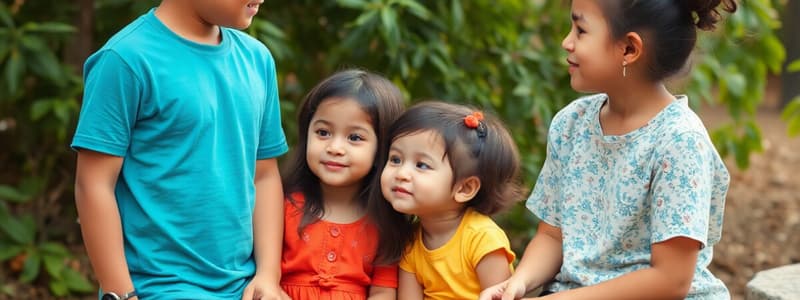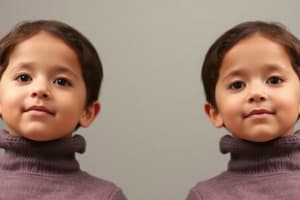Podcast
Questions and Answers
The process of developing a self-identity or self-concept has three phases: First, we imagine how we present ourselves to others, second, we imagine how others evaluate us, and third, we develop feelings about ourselves such as respect or ______.
The process of developing a self-identity or self-concept has three phases: First, we imagine how we present ourselves to others, second, we imagine how others evaluate us, and third, we develop feelings about ourselves such as respect or ______.
shame
The preparatory stage involves children imitating the people around them, especially ______ members.
The preparatory stage involves children imitating the people around them, especially ______ members.
family
Schools serve many manifest functions for society, including teaching skills and values thought to be ______.
Schools serve many manifest functions for society, including teaching skills and values thought to be ______.
appropriate
A peer group is a group of persons of roughly the same age who are linked by common ______.
A peer group is a group of persons of roughly the same age who are linked by common ______.
The family is the most important socializing agent during the first few years of ______.
The family is the most important socializing agent during the first few years of ______.
Socialization is the lifelong process of social interaction through which individuals acquire a ______ and the physical, mental, and social skills needed for survival in society.
Socialization is the lifelong process of social interaction through which individuals acquire a ______ and the physical, mental, and social skills needed for survival in society.
The two competing approaches grapple with the fundamental question of the origin of human ______.
The two competing approaches grapple with the fundamental question of the origin of human ______.
Social scientists tend to take the position that social relationships and the social ______ are key to normal human development.
Social scientists tend to take the position that social relationships and the social ______ are key to normal human development.
Human behavior and culture depend on ______, a shared system of communication.
Human behavior and culture depend on ______, a shared system of communication.
Babies do not ‘naturally’ develop into human adults; human interaction is required for them to acquire the traits we consider ______ for human beings.
Babies do not ‘naturally’ develop into human adults; human interaction is required for them to acquire the traits we consider ______ for human beings.
The transmission of characteristics from ancestors to their descendants is referred to as ______.
The transmission of characteristics from ancestors to their descendants is referred to as ______.
The surroundings in which a person finds him/herself affect the development of the ______.
The surroundings in which a person finds him/herself affect the development of the ______.
Genie was locked inside a room and strapped to her ______.
Genie was locked inside a room and strapped to her ______.
Genie had a very small vocabulary, consisting of about ______ words.
Genie had a very small vocabulary, consisting of about ______ words.
Oxana Malaya was found as an 8-year-old feral child in ______.
Oxana Malaya was found as an 8-year-old feral child in ______.
Oxana lived in a dog kennel behind her house and was cared for by ______.
Oxana lived in a dog kennel behind her house and was cared for by ______.
Genie's father would hit her with a ______ if she ever spoke.
Genie's father would hit her with a ______ if she ever spoke.
Vanya Yudin was also known as ‘the Russian ______ Boy’
Vanya Yudin was also known as ‘the Russian ______ Boy’
Feral children are supposedly lost or abandoned by their parents at a very early ______.
Feral children are supposedly lost or abandoned by their parents at a very early ______.
When found, Vanya Yudin was ______ years old.
When found, Vanya Yudin was ______ years old.
Oxana's parents were ______ and unable to care for her.
Oxana's parents were ______ and unable to care for her.
Vanya exhibited a lot of behaviors expected from a ______.
Vanya exhibited a lot of behaviors expected from a ______.
Genie was discovered in the year ______.
Genie was discovered in the year ______.
Child maltreatment includes forms of physical and emotional ______.
Child maltreatment includes forms of physical and emotional ______.
Children raised by animals are often referred to as ______ children.
Children raised by animals are often referred to as ______ children.
Five subtypes of child maltreatment include physical abuse and ______.
Five subtypes of child maltreatment include physical abuse and ______.
Oxana was found to have acquired extremely acute senses of hearing, smell, and ______.
Oxana was found to have acquired extremely acute senses of hearing, smell, and ______.
Anna was put in the ______ when she was taken back by her family.
Anna was put in the ______ when she was taken back by her family.
Due to her lack of care, Anna was extremely ______.
Due to her lack of care, Anna was extremely ______.
Isabella was discovered about 9 months after ______.
Isabella was discovered about 9 months after ______.
Isabella's mother was ______, which hindered communication.
Isabella's mother was ______, which hindered communication.
Isabella developed ______ due to her improper diet and lack of sunlight.
Isabella developed ______ due to her improper diet and lack of sunlight.
Primary socialization is taught by our immediate ______ and friends.
Primary socialization is taught by our immediate ______ and friends.
Secondary socialization involves socializing agents like school, ______, and media.
Secondary socialization involves socializing agents like school, ______, and media.
In childhood, socialization is focused on the regulation of biological ______.
In childhood, socialization is focused on the regulation of biological ______.
In adulthood, socialization involves specific norms related to ______ role.
In adulthood, socialization involves specific norms related to ______ role.
The socializee in childhood takes the status of ______ within the family context.
The socializee in childhood takes the status of ______ within the family context.
Harlow's research on rhesus monkeys demonstrated that social isolation can lead to fearful and ______ behavior.
Harlow's research on rhesus monkeys demonstrated that social isolation can lead to fearful and ______ behavior.
Genie was a 13-year-old girl who was isolated and locked in a small room, highlighting the importance of early social ______.
Genie was a 13-year-old girl who was isolated and locked in a small room, highlighting the importance of early social ______.
Adult socialization is often ______-initiated and voluntary.
Adult socialization is often ______-initiated and voluntary.
The content of socialization in adolescence focuses on the development of overarching ______ and self-image.
The content of socialization in adolescence focuses on the development of overarching ______ and self-image.
Flashcards
Socialization
Socialization
The lifelong process of acquiring a self-identity and essential skills for social life.
Nature vs. Nurture
Nature vs. Nurture
The debate on whether human behavior is primarily determined by innate traits or environmental influences.
Nature (Heredity)
Nature (Heredity)
Innate characteristics passed down from ancestors through genes. It's what we are born with.
Nurture (Environment)
Nurture (Environment)
Signup and view all the flashcards
Human interaction for development
Human interaction for development
Signup and view all the flashcards
Language and socialization
Language and socialization
Signup and view all the flashcards
Language as a shared system
Language as a shared system
Signup and view all the flashcards
Feral Child
Feral Child
Signup and view all the flashcards
Oxana Malaya
Oxana Malaya
Signup and view all the flashcards
Genie (Case Study)
Genie (Case Study)
Signup and view all the flashcards
Critical Period for Language
Critical Period for Language
Signup and view all the flashcards
Sensitive Period
Sensitive Period
Signup and view all the flashcards
Language Acquisition
Language Acquisition
Signup and view all the flashcards
Extreme Social Isolation
Extreme Social Isolation
Signup and view all the flashcards
Dog-like Habits
Dog-like Habits
Signup and view all the flashcards
Human Communication
Human Communication
Signup and view all the flashcards
Language Training
Language Training
Signup and view all the flashcards
Primary Socialization
Primary Socialization
Signup and view all the flashcards
Secondary Socialization
Secondary Socialization
Signup and view all the flashcards
Content of Socialization
Content of Socialization
Signup and view all the flashcards
Context of Socialization
Context of Socialization
Signup and view all the flashcards
Response to Socialization
Response to Socialization
Signup and view all the flashcards
Social Isolation Effects
Social Isolation Effects
Signup and view all the flashcards
Genie's Case
Genie's Case
Signup and view all the flashcards
Importance of Socialization
Importance of Socialization
Signup and view all the flashcards
Looking-Glass Self
Looking-Glass Self
Signup and view all the flashcards
Stages of the Self
Stages of the Self
Signup and view all the flashcards
Family
Family
Signup and view all the flashcards
School
School
Signup and view all the flashcards
Peer Group
Peer Group
Signup and view all the flashcards
Child Maltreatment
Child Maltreatment
Signup and view all the flashcards
Physical Abuse
Physical Abuse
Signup and view all the flashcards
Sexual Abuse
Sexual Abuse
Signup and view all the flashcards
Neglect
Neglect
Signup and view all the flashcards
Emotional Abuse
Emotional Abuse
Signup and view all the flashcards
Exploitation
Exploitation
Signup and view all the flashcards
Vanya Yudin (The Russian Bird Boy)
Vanya Yudin (The Russian Bird Boy)
Signup and view all the flashcards
Anna's Case
Anna's Case
Signup and view all the flashcards
Isabella's Case
Isabella's Case
Signup and view all the flashcards
Study Notes
Socialization
- Socialization is a lifelong process of social interaction where individuals acquire self-identity and the skills needed for survival in society
- It's a process by which we learn societal norms
- Socialization shapes us into human beings through interaction
Nature vs Nurture
- The study of human experience is centered on the nature vs nurture debate.
- This debate questions whether an individual's destiny, preferences, and actions are inborn or biologically derived, or if they're influenced by culture, historical era, and social groups.
- Social scientists emphasize social relationships and environment as key to normal human development and understanding behaviours.
Nature (Heredity)
- Transmission of characteristics from ancestors to descendants through genes ('built into a person from the beginning')
Nurture (Environment)
- The surrounding environment in which a person is found affects their development.
Social Isolation
- Studies of animals raised in isolation show the significance of socialization in development.
- Harlow Research (1971) involving rhesus monkeys raised isolated from their mothers and other monkeys highlighted the negative effect of isolation. The monkeys exhibited fear, weren't able to mate, and the females became abusive mothers
- Isolated children, such as Genie (kept locked in a small room for years) and Oxana Malaya (raised by dogs), also demonstrate the importance of early social interaction for development and language acquisition
Isolated Children
- Isolated children show how human development can be impacted by isolation from society at an early age
- These instances demonstrate the importance of early social interaction.
- Genie and Oxana Malaya are notable cases.
Child Maltreatment
- Child maltreatment, including physical and emotional abuse, neglect, and exploitation, can harm the child's health, development, and dignity.
- Specific subtypes include physical abuse, sexual abuse, neglect, and exploitation
- Instances such as Anna and Isabella highlight the negative effects of child maltreatment on development
Anna's Case
- Anna was born in 1932.
- She was a child of a farm girl
- Anna was born in 1932, a child of a farm girl with a disapproving father
- Later abandoned by her family, and lived in an attic
- She did not learn to walk, talk, etc., at the age of six, and was extremely malnourished
- While under her mother's care she was pretty much only fed cow's milk
Isabella's Case
- Isabella was born to an illegitimate mother; the mother was forced to keep her.
- She Spent most of her time in the dark, due to mother's deafness and fear of strangers
- Her mother made croaking sounds and she had an inadequate diet
- She had rickets, and her legs were extremely bowed
Sociological Approaches to Socialization
- The Looking-Glass Self (Cooley, early 1900s): Individuals develop self-identity through imagining how others perceive them, how others evaluate us, and how we develop feelings as a result
Stages of the Self (Mead, 1934)
- Preparatory stage: Imitating others, especially family members.
- Play stage: Pretending to be other people
- Game stage: Considering multiple roles and relationships simultaneously
Agents of Socialization
-
The Family: Most important during early years, significantly impacted by factors such as divorce, and ethnic/cultural background
-
School: Places children outside the immediate control of their families; teaches values, rules and ways of understanding the world
-
Peer Group: Next to family, the most powerful socializing force; driven by common interests
-
Mass Media and Technology: Including books, magazines, newspaper, radio, movies, television, internet; becoming major sources of information for children; can affect them positively or negatively
-
Religion: Religious practices and teachings.
-
Workplace: Workplace norms and values.
-
Sports Teams: Group values and behaviours associated with sports.
Gender Socialization
- Biological sex is a significant factor, with society expecting different behaviors for males and females.
- Children learn gender roles and appropriate behaviors for each gender from various sources.
- This early learning shapes attitudes and expectations for adult life.
Re-Socialization
- Refers to the process of learning new norms, values, attitudes, and behaviours
- It happens in situations where individuals are expected or required to adopt new values or behaviours
- This can be voluntary or forced by total institutions
Total Institutions
- Coinined by Erving Goffman
- These are places where people are isolated from society and under tight control
- Include boot camps, prisons, mental hospitals, religious cults and residential schools
- People are isolated from the outside, activities are supervised, previous norms and roles are replaced with new rules and values
Conclusion
- Sociologists focus on nurture aspects when discussing "nature" versus "nurture."
- Family remains important in socialization while media and technology are increasing in importance.
- Re-socialization can occur voluntarily or be forced by total institutions
Studying That Suits You
Use AI to generate personalized quizzes and flashcards to suit your learning preferences.




